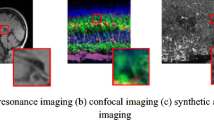Abstract
This paper presents a novel image denoising framework using overcomplete topographic model. To adapt to the statistics of natural images, we impose both spareseness and topograpgic constraints on the denoising model. Based on the overcomplete topographic model, our denoising system improves the previous work on the following aspects: multi-category based sparse coding, adaptive learning, local normalization, lasso shrinkage function, and subset selection. A large number of simulations have been performed to show the performance of the modified model, demonstrating that the proposed model achieves better denoising performance.









Similar content being viewed by others
References
Aharon M, Elad M, Bruckstein A (2006) \(k\)-svd: an algorithm for designing overcomplete dictionaries for sparse representation. IEEE Trans Signal Process 54(11):4311–4322
Buades A, Coll B, Morel JM (2005) A non-local algorithm for image denoising. In: Computer Vision and Pattern Recognition, 2005. CVPR 2005. IEEE Computer society conference on, vol 2, pp 60–65
Chang S, Yu B, Vetterli M (2000) Adaptive wavelet thresholding for image denoising and compression. IEEE Trans Image Process 9(9):1532–1546
Dabov K, Foi A, Katkovnik V, Egiazarian K, et al (2009) Bm3d image denoising with shape-adaptive principal component analysis. In: SPARS’09 signal processing with adaptive sparse structured representations
Dong W, Li X, Zhang L, Shi G (2011) Sparsity-based image denoising via dictionary learning and structural clustering. In: CVPR 2011, pp 457–464
Elad M, Aharon M (2006) Image denoising via sparse and redundant representations over learned dictionaries. IEEE Trans Image Process 15(12):3736–3745
Hinton GE, Salakhutdinov RR (2006) Reducing the dimensionality of data with neural networks. Science 313(5786):504–507
Hyvärinen A, Hoyer P, Oja E (1999) Image denoising by sparse code shrinkage. In: Intelligent signal processing. IEEE Press, Boca Raton
Hyvärinen A, Hoyer PO, Inki M (2001) Topographic independent component analysis. Neural Comput 13(7):1527–1558
Jain V, Seung HS (2008) Natural image denoising with convolutional networks. In: NIPS, vol 8. pp 769–776
LeCun Y, Bengio Y (1995) Convolutional networks for images, speech, and time series. In: The handbook of brain theory and neural networks, p 3361
Ma L, Zhang L (2007) A hierarchical generative model for overcomplete topographic representations in natural images. In: IJCNN 2007, pp 1198–1203
Ma L, Zhang L (2008) Overcomplete topographic independent component analysis. Neurocomputing 71(10):2217–2223
Mairal J, Bach F, Ponce J, Sapiro G, Zisserman A (2009) Non-local sparse models for image restoration. In: CVPR 2009, pp 2272–2279
Pati Y, Rezaiifar R, Krishnaprasad P (1993) Orthogonal matching pursuit: recursive function approximation with applications to wavelet decomposition. In: Conference record of The twenty-seventh Asilomar conference on signals, systems and computers, vol 1. pp 40–44
Tibshirani R (1996) Regression shrinkage and selection via the lasso. J R Stat Soc Ser B (Methodological) 58:267–288
Vincent P, Larochelle H, Lajoie I, Bengio Y, Manzagol PA (2010) Stacked denoising autoencoders: learning useful representations in a deep network with a local denoising criterion. J Mach Learn Res 11:3371–3408
Xie J, Xu L, Chen E (2012) Image denoising and inpainting with deep neural networks. In: NIPS, pp 350–358
Zhao H, Zhang L (2011) Sparse coding image denoising based on saliency map weight. In: ICONIP 2011, LNCS, vol 7063. Springer, Berlin, pp 308–315
Zhao H, Luo J, Huang Z, Nagumo T, Murayama J, Zhang L (2013) Image denoising based on overcomplete topographic sparse coding. In: Lee M, Hirose A, Hou ZG, Kil R (eds) Neural information processing. Lecture notes in computer science, vol 8228. Springer, Berlin, pp 266–273
Acknowledgments
The work of H. Zhao and L. Zhang was in part supported by the National Natural Science Foundation of China (Grant No. 61272251, 91120305).
Author information
Authors and Affiliations
Corresponding author
Rights and permissions
About this article
Cite this article
Zhao, H., Luo, J., Huang, Z. et al. Statistically Adaptive Image Denoising Based on Overcomplete Topographic Sparse Coding. Neural Process Lett 41, 357–369 (2015). https://doi.org/10.1007/s11063-014-9384-3
Published:
Issue Date:
DOI: https://doi.org/10.1007/s11063-014-9384-3




